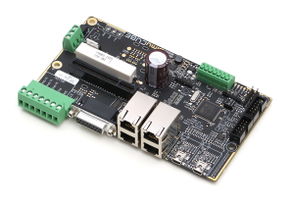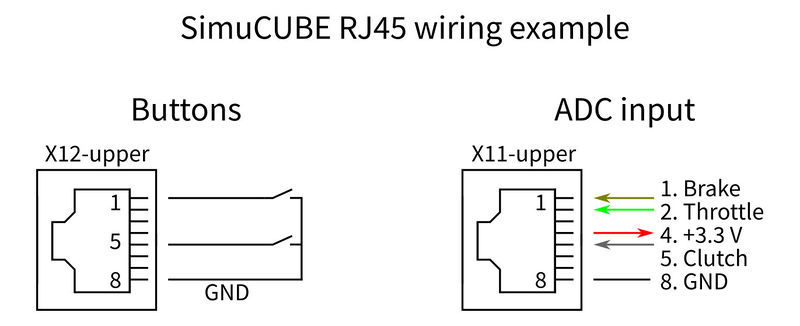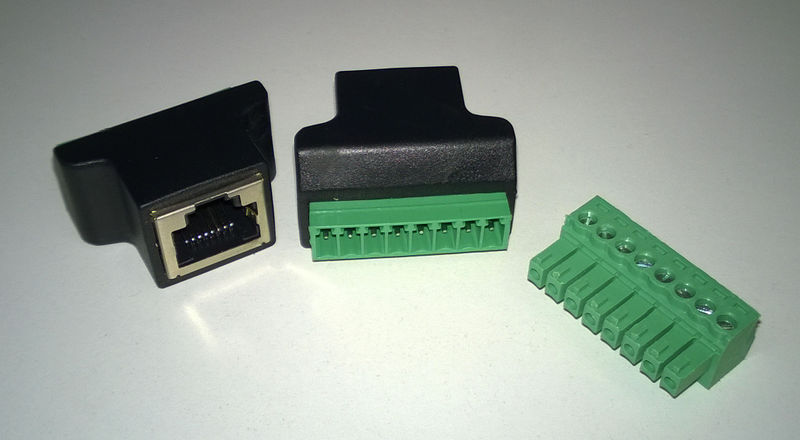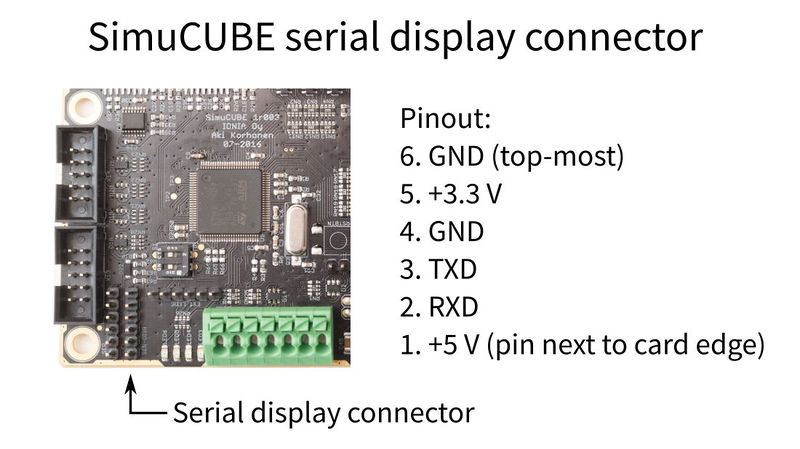About SimuCUBE
| SimuCUBE | |
|---|---|
 | |
| Device type | Single axis motherboard for IONI drives |
| Model number | SimuCUBE |
| Supported motors | AC, DC, BLDC, Linear, Stepper |
| Control modes | Position, Velocity, Torque |
| Status | Active production, started 2016 |
| Electrical | |
| DC supply voltage | Same as IONI specifications |
| General | |
| Compliance | CE (EMC & LVD directives) |
| 3D model |
TBA |
| This section is unfinished. Don't use until this notice is removed. |
External connectors
Legend
| Color |
|---|
| Supply pin |
| Input pin |
| Output pin |
X1 - Motor & E-stop connector
Pin 1 is the left-most.
| Pin number | Signal name | Usage |
|---|---|---|
| 1 | U / PH1 | Motor phase 1 |
| 2 | V / PH2 | Motor phase 2 |
| 3 | W / PH3 | Motor phase 3 |
| 4 | PH4 | Motor phase 4 |
| 5 | GND | Ground voltage (0 V) of the SimuCUBE |
| 6 | E-Stop / STO | External stop / Safe Torque Off input pin (active high) |
| 7 | +5 V | 5 V supply voltage. |
X16 - Motor position sensor connector
A, B, and C indicate the quadrature encoder differential signals.
| Pin # | Pin name | Electrical type (in most feedback device modes) |
|---|---|---|
| Shell | GND | Earth / 0 V |
| 1 | HALL_W | Hall sensor digital input W |
| 2 | HALL_V | Hall sensor digital input V |
| 3 | HALL_U | Hall sensor digital input U |
| 4 | GND | Encoder supply ground / 0 V |
| 5 | B- | Encoder differential input B- |
| 6 | B+ | Encoder differential input B+ |
| 7 | A- | Encoder differential input A- |
| 8 | A+ | Encoder differential input A+ |
| 9 | 5V_OUT | Encoder supply +5 V output |
| 10 | GND | Encoder supply ground / 0 V |
| 11 | GPI3 | IONI GPI3 input |
| 12 | GPI2 | IONI GPI2 input |
| 13 | GPI1 | IONI GPI1 input |
| 14 | C- | Encoder differential input C- |
| 15 | C+ | Encoder differential input C+ |
RJ45-1 (top-left)
Pin 1 is the right-most. These are active-low with an internal 3.3 kOhm pull-up resistor.
| Pin number | Signal name | Usage |
|---|---|---|
| 1 | Button 12 | |
| 2 | Button 7 | |
| 3 | Button 8 | |
| 4 | Button 9 | |
| 5 | Button 10 | |
| 6 | Button 6 | |
| 7 | Button 11 | |
| 8 | GND / 0 V |
RJ45-2 (bottom-left)
Pin 1 is the right-most. These are active-low with an internal 3.3 kOhm pull-up resistor.
| Pin number | Signal name | Usage |
|---|---|---|
| 1 | Button 3 | |
| 2 | Button 4 | |
| 3 | Button 2 | |
| 4 | Button 5 | |
| 5 | Button 13 | |
| 6 | Button 14 | |
| 7 | Button 15 | |
| 8 | GND / 0 V |
RJ45-3 (top-right)
Pin 1 is the left-most.
| Pin number | Signal name | Usage |
|---|---|---|
| 1 | ADC12_IN9 | ADC input for brake pedal |
| 2 | ADC12_IN8 | ADC input for throttle pedal |
| 3 | ADC12_IN15 | ADC input |
| 4 | 5V_OUT | +5 V supply |
| 5 | ADC12_IN4 | ADC input for clutch pedal |
| 6 | ADC12_IN7 | ADC input |
| 7 | HX711_CLKOUT | |
| 8 | GND / 0 V |
RJ45-4 (bottom-right)
Pin 1 is the left-most.
| Pin number | Signal name | Usage |
|---|---|---|
| 1 | Button 16 | |
| 2 | ADC123_IN13 | ADC input |
| 3 | ADC123_IN3 | ADC input |
| 4 | 5V_OUT | +5 V supply |
| 5 | ADC12_IN4 / DAC1 | ADC input / DAC output |
| 6 | ADC12_IN5 / DAC2 | ADC input / DAC output |
| 7 | ADC12_IN6 | ADC input |
| 8 | GND / 0 V |
USB Connectors
| Connector | Usage | Notes |
|---|---|---|
| USB-1 | USB connector for the HID | |
| USB-2 | USB connector for the IONI |
Wiring
Basic wiring scheme

SimuCUBE basic wiring scheme. Please see the motor position sensor table for the DB15 connector pinout.
RJ45 connectors
Serial display
Pin headers & other connectors
The SimuCUBE has few pin headers for future upgrades and features. These are reserved until future notice.
Configuration files
Note: this is heavily work in progress. This section will be on separate page with more detailed step-by-step guide.
SimuCUBE firmware installation/upgrade
Please read the following guide, how to update the STM32F4 firmware.
SimuCUBE firmware files
| FW version | FW file | Description/changes |
|---|---|---|
IONI firmware
Read the following guide how to upgrade the IONI firmware:
The latest firmware can be found here:
Note: SimuCUBE requires IONI firmware 1.5.0 beta or newer! Also be sure to use latest Granity version where you can choose Granity parameter Electrical interfaceCEI to be SimuCUBE. Choosing this mode is necessary to make IONI drive operate on SimuCUBE.
Motor configuration files for Granity (.drc)
If you have a working configuration file for a specific motor, we would like to add it here.
Note: the inertia of the wheel affects the motor tuning parameters, so a configuration file for a specific motor can only be regarded as an example. Please refer to the Servo tuning basics and tuning torque controller pages later in this document.
| Motor name | Motor model | Notes | Configuration file | Contributor |
|---|---|---|---|---|
| Mige (small) | Mige 130ST-M10010 | 1 kW, 10 Nm (20 Nm peak) | file here someday | Granite Devices Inc. |
| Mige (large) | Mige 130ST-M15015 | 2.3 kW, 15 Nm (30 Nm peak) | file here someday | Granite Devices Inc. |
| Lenze | MCS12H15L | 1.6 kW, 11.4 Nm (29 Nm peak) | file here someday | Granite Devices Inc. |
Links and miscellaneous notes
If you are not using a ready configuration file for Granity, then please read servo tuning basics and torque tuning very carefully to get the idea how it's done. Every servo type requires specific parameters.
Please read also these pages to get the best possible experience of a SimuCUBE FFW system.
In no event the Product Information or parts hereof shall be regarded as guarantee of conditions or characteristics. The Product Information or any part thereof may also not be regarded as a warranty of any kind. No liability of any kind shall be assumed by Author with respect to Product Information or any use made by you thereof, nor shall Author indemnify you against or be liable for any third party claims with respect to such information or any use thereof.
As content of this Wiki may be edited by user community, Granite Devices Oy or it's affiliates do not take any responsibility of the contents of this Wiki. Use information at your own risk. However, Granite Devices staff attempts to review all changes made to this Wiki and keep information trustworthy.
Without written consent, Granite Devices' Products or Intellectual Property shall not be used in situations or installations where living beings, material property, or immaterial property could be harmed by the operation, features or failures of Product. Products may only be used in a way where hazards like moving parts, electric shock, laser radiation, or fire can't be realized even if the content of this Wiki would suggest otherwise.



